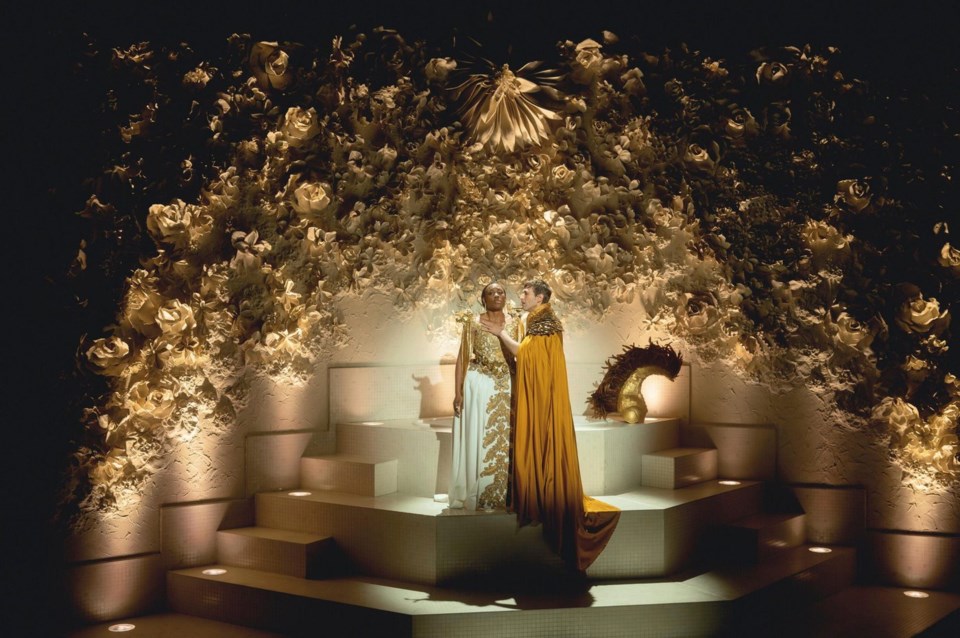NEW YORK (AP) ã Nero's ancient Rome and Jazz Age New York were similar.
That is the message of ãThe Comet/Poppea,ã an intriguing combination of Monteverdiãs 1643 opera ãLãincoronazione di Poppeaã and George E. Lewis' ãThe Comet,ã a Pulitzer Prize finalist this year. The mashup conceived by began a five-performance run at Lincoln Center's Summer for the City on Wednesday night.
First seen in Los Angeles last year, the American Modern Opera Company production unfolds on a turntable that completes a spin each 2 minutes, 8 seconds. An audience of 290 is split into sections on opposite sides of the set on stage at the David Koch Theater while the venue's 2,586 auditorium seats remain empty.
ãItãs an unstable ride over the course of 90 minutes, and the power of the interpretation is up to each and every spectator,ã Sharon said. ãWhether youãre on one side of the seating bank or the other, youãre going to have a totally different experience and you may miss a really important piece of action that your imagination is going to have to fill.ã
In Monteverdiãs final opera, created to Giovanni Francesco Busenelloãs libretto, Nerone exiles his wife Ottavia, leaving him free to crown Poppea empress.
Lewis composed ãThe Cometã to librettist Douglas Kearneyãs adaption of W.E.B. Du Boisã dystopian eight-page 1920 short story in which a working-class Black man, Jim (Davû°ne Tines), and a society white woman, Julia (Kiera Duffy), believe they are the only survivors of a comet and can join to form a prejudice-free society. Their aspirations collapse when they learn people outside New York remained alive and segregation was unconquerable.
ãPeople can make the leap between the music theyãre hearing and the kinds of tensions that are inherent to modern life and the tensions that the opera presents and the text presents, particularly around the dystopian aspect of white supremacy,ã Lewis said. ãWhite supremacy is a kind of dystopia and itãs a dystopia that we continue to live with today."
Different styles for different eras
Mimi Lien's two-sided set, illuminated strikingly by John Torres, is tiered with a bath at the top level on the Roman portion and a red Art Deco restaurant evoking the Rainbow Room on the other, where Jim and Julia find three dead bodies slumped.
ãJim is confronted with what it means to be the only man left alive, what it newly means to be a Black man allowed into spaces he wasnãt before, but then have that dream crushed by the reality of Julia also inhabiting that space," said Tines, a commanding presence as Jim and the smaller role of Mercury.
ãThe Comet/Poppeaã debuted at The Geffen Contemporary at MOCA last June and also was performed with a student cast in Philadelphia in November. It is part of a Run AMOC(asterisk) festival of 12 productions at Lincoln Center that include 10 New York premieres. Fridayãs performance can been viewed on a live stream on Lincoln Centerãs Facebook and YouTube channels.
Planning, writing and funding took years
Sharon first discussed the project in 2018 with , who sings Nerone and Juliaãs father, a stuffed shirt dressed like Mr. Monopoly.
ãIt fell apart so many times,ã Constanzo said. ãFirst, the pandemic came, and so all of our plans weãd put together were dashed. Then we had one co-producer who was giving a lot of money and they pulled out. Then we got another co-producer to put that much money in again and they pulled out."
Sharon had met Lewis at a 2018 Columbia University conference and approached him with the idea of concentrating on Poppeaãs upward mobility and creating ãa secondary story to complicate and to make a mess of this idea of authoritarianism.ã Sharon trimmed ãPoppeaã to its essence.
Lewis' music, filled with dissonance and a snippet of jazz, mixes with the Monterverdi's baroque, which Jim first hears from the restaurant jukebox.
ãThe conception was one in which you knew from the beginning that there are moments of overlap, there are moments of exchange, of sequentiality,ã Lewis said. ãIt could stand alone by itself, `The Comet,' certainly."
Lincoln Center is presenting a more ambitious offering of classical events after drawing criticisms in the first three seasons of Summer for the City that . There are 266 scheduled events from June 11 through Aug. 9. Programs are set to include jazz, Latin music, R&B, Broadway, pop, Caribbean, dance and more. ___ This story corrects the audience count to show 290 people attended, not 380.
Ronald Blum, The Associated Press



